Jan 21 2011
January 2012 VHF Contest
The Olympic Peninsula is way off in the far corner of the Pacific Northwest and offers a huge area of remote, isolated and largely undeveloped wilderness. The peninsula has but one single main road, Highway 101, which gives access to the distant coastline. Although most of it is within a hundred miles of the densely populated greater Seattle area, the tall peaks in the Olympic Mountain range will block radio propagation from the coastline. And the winter weather blocked drivable access to ridges and peaks. All of this along with our recent severe local weather, makes it a challenge for the 2012 VHF Contest that we couldn't resist.
Rod WE7X and Barry WA7KVC made a driving adventure to activate rare grid squares on the Olympic Peninsula coastline on January 21-22 during the ARRL January 2012 VHF Contest.
Our goal was to activate the remote lowland coastal grids in the state during the VHF contest. This is the dead of winter in the Pacific Northwest so other possible destinations that involved "hilltopping" or other parts of the state with mountainous inland grids were not considered, especially in light of our recent weather. The Seattle area was still digging out from snowfall, ice storms, downed trees, mudslides, widespread power outages and road closures. To set the stage, you should realize that Rod's home had been without power for two days before, and his neighborhood was still dark when we returned. Barry's house had power restored just the night before we left.
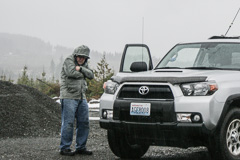
Our plan to target the "warmer" ocean coast turned out to be mostly successful — at least it didn't rain all the time during our trip. Sometimes it snowed for awhile instead.
During the 650-mile drive, our constant companions were rain, cold, wind, squalls, snow and fog. But it was fabulously scenic. Thankfully the 4Runner's broad liftgate provided shelter from the worst elements when we stopped and put up the 2-meter beam at the back of the truck. All we had to do is remember to park pointing into the wind.
Route
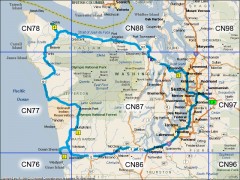
We drove clockwise around the Olympic Peninsula, thinking that we should activate the single most difficult grid square (CN78 at Sekiu) on Sunday morning during the VHF weak-signal net. This turned out to be a Good Idea because it gave us a better chance of reaching the most capable VHF stations when we occupied the most remote grid square. It was difficult to make any contacts but we achieved a few by bouncing signals from Mt Baker.
Rover Highlights
The contest began Saturday morning, 11 am local time, and we set up in Ocean Shores. This is a thin slice of land that juts into CN76 with wide, flat open areas. In summertime, this is packed with tourists and beach lovers. In winter, it's practically a ghost town. The local airport's parking lot was empty except for shorebirds and offered unobstructed propagation toward Seattle.
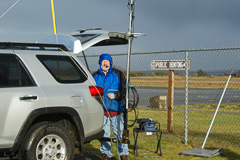
Barry WA7KVC starts operating at Ocean Shores when the contest begins.This view is looking east toward Seattle across the inland bay at the small local airport.
The town of Copalis is rich with character, some of which is designed to lure campers and tourists.
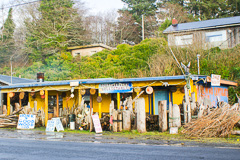
A golden sun spurting crepuscular rays across the heavens while it sets behind a cloud bank over the crashing surf is always a huge inspirational thrill, even in near-freezing temperatures.


We discovered that our mobile 144 MHz stacked loops worked surprisingly well on 432 MHz. This is triple the resonant frequency so I suppose we shouldn't be so surprised. The mobile mast carried loops for 50 MHz, 144 MHz and 220 MHz. The little 220 MHz loops went unused as we didn't carry a radio for that band.
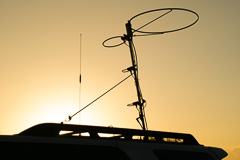
We scouted the route to North Point (Kloshe Nanitch Lookout), a nice high 3,000' ridge in the closer part of CN78. The road was totally blocked by recent snow to the extent that its forest path was unfindable.
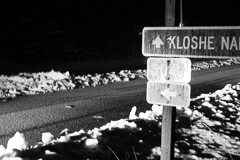
Instead of North Point, we went to a spot near the Sekiu airport, a distant second choice in altitude and desirability, but it's the best we could do in an area simply chock full of poor choices.

I love the banter you can use when calling from CN78: “CQ CQ, CQ Sekiu, CQ from Sekiu, CQ to Sekiu, and CQ everywhere else”. I think that all active hams should have a chance to visit a place that can help spread so much mind-boggling confusion.
Crossing grid lines is always exciting. Just when you think the bands died or the antenna fell off, you cross a grid line and suddenly become extremely popular again. All grid line crossings were like this, but when we entered CN97 above Issaquah Highlands on the plateau at 1,001-foot elevation, we enjoyed a real pile-up. Rod made 15 contacts in 10 minutes.

A blizzard at night driving from Forks to Port Angeles caused almost white-out conditions. Indeed, there was snow alongside the road on the entire route and snowplows were few and far between.
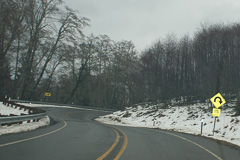

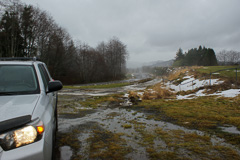
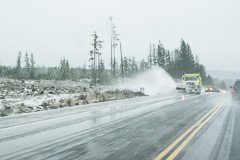
It was a new experience to send CW in conditions so cold that two-finger gloves are required.

January is so far off the tourist season in Port Angeles that one of their best Fish-n-Chips restaurants closed early: 7pm Saturday!
We pulled into a Super-8 hotel in Port Angeles, and their entry overhang looked quite high. Imagine our surprise when we step out to discover the loops had just cleared it by an inch. If we'd parked a little to the left then it would've had a nasty dispute with a light fixture.

Testing New Gear
A large part of this trip's purpose was to try out a wide variety of new equipment:

New Toyota 4Runner — a very capable truck that makes some unthinkable spots possible and some difficult conditions easy. It has lots of storage room and good road manners at all speeds in all conditions.
Biggest problem: while operating at the back end, the rainwater pools in the liftgate and later, when you pull down the hatch, makes itself known. The icy water takes a diabolically unavoidable path down your arm and into your neck and armpit.
Second biggest problem: In spite of its advanced hill-climbing features, a new 4Runner still won't let you climb a forest trail up to a 3,000' ridge on a road that is so buried under snow that it's unfindable.
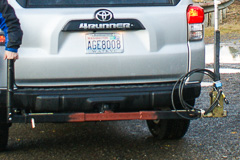 New trailer hitch T-adapter — this allows two versatile side mounting positions, where we could have two masts while not blocking the rear hatch access.
New trailer hitch T-adapter — this allows two versatile side mounting positions, where we could have two masts while not blocking the rear hatch access.
Biggest problem: Rod is keeping it for himself. So, just because he provided the entire idea, design, parts, labor, construction, painting, installation and testing, why does he think he can keep this dandy device?
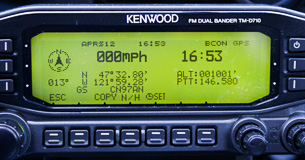 New TM-D710 dual band mobile radio — integrates with Avmap G5 and supports APRS and displays your six-digit grid square with a handy continuous dashboard display.
New TM-D710 dual band mobile radio — integrates with Avmap G5 and supports APRS and displays your six-digit grid square with a handy continuous dashboard display.
Biggest problem: there were no APRS receiving stations around most of the Olympic Peninsula to bridge our position to the Internet.
 M2 seven-element 2-meter beam on a 15' mast — terrific gain, f/b ratio, low SWR, portability and light weight. This let us bounce a signal from CN78 (Sekiu) off of Mt Baker and work a few stations in Seattle.
M2 seven-element 2-meter beam on a 15' mast — terrific gain, f/b ratio, low SWR, portability and light weight. This let us bounce a signal from CN78 (Sekiu) off of Mt Baker and work a few stations in Seattle.
Biggest problem: you just don't need these features for the other 90% of the contacts around the greater Seattle area. The horizontal loops on an 8′ mobile mast works just fine for a lot of quick contacts.
New deep-cycle storage battery — its huge 134 amp-hour capacity could probably have powered both VHF radios for the entire weekend.
Biggest problem: the battery went untested and unused since I forgot to connect it. We were a half hour late starting the contest in Ocean Shores (CN76) and rushed through setup and then never moved the power connections.
Results
The overall contest activity was very light. The recent ice and snow storms probably reduced the participation from everyone across the Pacific NW. There were no good 6-meter or 2-meter openings during the trip and we only made three Canadian contacts.
| Band | From CN76 | From CN77 | From CN78 | From CN87 | From CN88 | From CN97 | Total |
| 50 MHz | 2 | 4 | — | 14 | 10 | 14 | 47 |
| 144 MHz | 4 | 4 | 9 | 17 | 4 | 12 | 50 |
| 432 MHz | — | — | — | — | — | 6 | 6 |
| Total Contacts | 6 | 8 | 9 | 31 | 14 | 35 | 103 |
This was my first two-person rover contest operation. It was highly enjoyable and a rather successful trip, activating six grids resulting in 103 contacts for an estimated score of 2,398 points.


